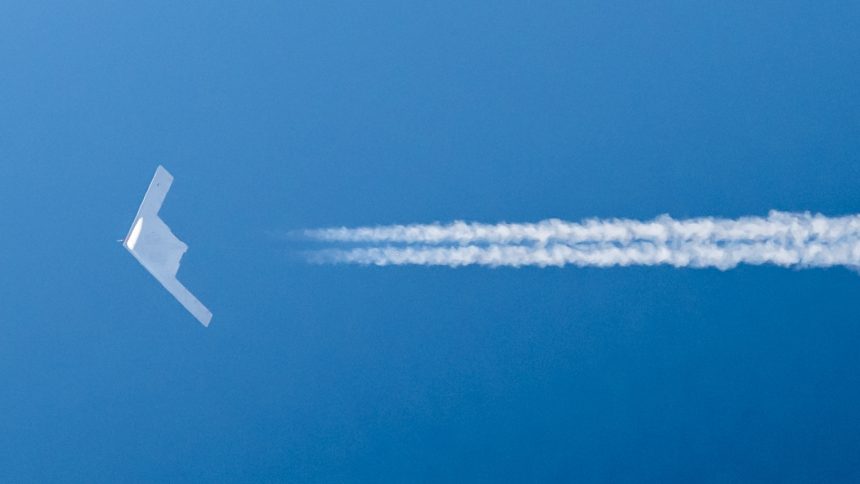Sightings of the secretive B-21 Raider flying at high altitude continue. And we can’t get enough of the incredible photos captured during test flights.
In the last few weeks we have published several cool shots of the Northrop Grumman B-21 Raider during its test flights out of Edwards Air Force Base taken by West Coast aviation photographers.
The last ones were taken by AAron Maurer (@maurer8photography on Instagram) on Nov. 7, 2024, as a Raider bomber, accompanied by an F-16 chase plane, flew at high altitude over Mojave, producing the usual, quite evident contrails.
“Being around the Aerospace Valley for some time I’ve learned to always look up at the sound of an aircraft or sight of a contrail,” Aaron told us in an email.
“Yesterday I was outside, not specifically looking for aircraft, when something unfamiliar caught my eye. Seeing a pair of contrails approaching I quickly grabbed my camera to check it out. I couldn’t believe my luck when the B-21 with an F-16 chase came into focus on the screen. I took a few photos and watched as the they turned north and disappeared out of view. I anxiously watched the sky for them to return, but they never did. I was not using a scanner, just pure luck of looking up at the right time and having a camera ready.
It was an incredible sight!”
The photos taken by Maurer with a Nikon Z9 and a Nikkor 180-600 lens, are quite impressive: despite the distance, the exhaust section as well as the pitot tube are clearly visible!
View this post on Instagram
That being said, as happened with other B-21 photos we commented recently, these shots don’t reveal new information about the bomber, since it was already known that the Raider is a twin-engine aircraft, and its general shape was shown in images from its first flight. Dealing with the contrails and the usual complain “it’s not very stealth”, we can’t but highlight that the B-21 is arguably equipped with a contrail sensor similar to that of the B-2, which notifies pilots when they need to adjust the altitude of the stealth bomber to minimize contrail formation. It’s evidently not being used in the current flight testing phase (and, it’s generally not used by the B-2s when they fly over the continental US, as images we posted here at The Aviationist in the past prove).
Latest updates
On Nov. 10, 2023, the Northrop Grumman B-21 Raider flew for the first time moving from Air Force Plant 42 at Palmdale, California, to Edwards AFB, where the B-21 Combined Test Force (CTF) operates. Testing is currently underway on three Raider aircraft: one is used for flight evaluations whereas two are dedicated to ground tests.
The CTF is currently able to carry out up to two test flights weekly, with plans to expand to daily flights.
Shortly after the B-21 began its test flights, Northrop Grumman was awarded the contract for the Raider’s Low-Rate Initial Production (LRIP). Although specific contract details remain classified, previous Air Force estimates have placed the unit cost at around $692 million.
In recent remarks at the Military Reporters and Editors conference in October 2024, Gen. David W. Allvin suggested that the B-21’s mission scope could expand. With the costly NGAD (Next Generation Air Dominance) program, estimated at $300 million per manned unit, under review, the Air Force is exploring the Raider’s potential as an air dominance platform in addition to its primary role in strategic strikes. Gen. Allvin did not explicitly confirm an air-to-air role for the B-21; however, he hinted at this possibility. “We have not taken that off the table,” Allvin siad.
If adapted for an air-to-air role, the B-21 could serve as a powerful “arsenal plane,” carrying long-range missiles like the secretive AIM-260 Joint Advanced Tactical Missile (JATM) to deter or neutralize enemy formations. This would leverage the B-21’s stealth and data-linking capabilities, allowing it to operate effectively alongside CCAs and manned NGAD aircraft.
A role in Suppression of Enemy Air Defenses (SEAD) and Destruction of Enemy Air Defenses (DEAD) missions, using anti-radiation missiles or deploying decoys to lure enemy radar, is also being discussed. Its sophisticated sensor fusion and digital architecture allow the Raider to process and respond to complex electromagnetic data, positioning it as a versatile tool for a range of missions. Additionally, reports suggest that its onboard power generation capabilities are robust, further enhancing its potential for SEAD/DEAD operations.
Anyway, over the coming months, the Air Force may decide whether to formally expand the Raider’s mission profile. In the meantime, let’s enjoy some outstanding “snapshots” of the only 6th generation aircraft currently flying (that we are aware of), taken by Aaron and the other photographers as the new stealth bomber soars over the U.S. West Coast.
A big Thank You to Aaron Maurer for sharing his awesome photos with us. Don’t miss out—give him a follow on Instagram!









